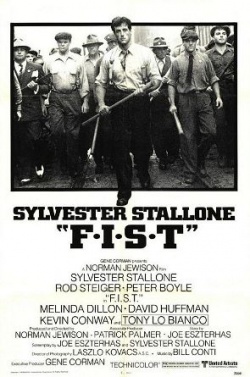Encyclopedia Dubuque
"Encyclopedia Dubuque is the online authority for all things Dubuque, written by the people who know the city best.”
Marshall Cohen—researcher and producer, CNN
Affiliated with the Local History Network of the State Historical Society of Iowa, and the Iowa Museum Association.
F.I.S.T.
F.I.S.T. This 1978 movie directed by Oscar-nominated Norman Jewison starred Sylvester Stallone, the writer and star of Rocky, the Best Picture of 1977. (1) Stallone played a Cleveland warehouse worker "Johnny Kovak" who becomes involved in the labor union leadership of the fictional "Federation of Inter-State Truckers." Kovak sacrifices his principles as he moves up through the union and attempts to expand its influence.
Dubuque was in competition with Memphis, Tennessee; St. Louis, Missouri; and Minneapolis-St. Paul, Minnesota as the setting for the movie. (2) The disclosure that the film would be made in Dubuque was announced to a select group of local citizens on February 22, 1977. By February 27th, producers were asking anyone in the area with trucks, semi-trailers, or other vehicles manufactured between 1929 and 1939 to contact them. Plans carried for the vehicles to be rented and insured for two months. Even vehicles that did not operate were wanted for "atmosphere." (3) It was announced that the film would have an $8 million budget and be a major project for United Artists. Among the reasons given for the selection of Dubuque was the absence of television antennas that would conflict with the look of the 1930s, the era in which the movie's action was to take place.
Filming began on May 9 and continued through June. An army of extras was provided with haircuts of the era, costumes, and props. Portions of the CARADCO building were fitted with new windows that were purposely smashed during filming and then replaced before the company left town.
Perhaps the most attention was reserved for Stallone who worked in a guarded room at the Julien Motor Inn on the script for a sequel to "Rocky," a film called Paradise Alley. Occasionally Stallone ventured out with his bodyguard providing fortunate residents with a view of the star off the set.
The last filming took place on July 1st in the basement of SACRED HEART CHURCH. Seven Dubuque-area residents moved west with the crew of F.I.S.T. John Cahill, Stallone's chauffeur in Dubuque, accompanied the actor on his next Rambo movie.
In February 1978, the TELEGRAPH HERALD announced the newest official Dubuque CITY DIRECTORY contained some unexpected entries. Page 309 listed both John and Anna Kovaks, the fictional characters portrayed by Stallone and co-star Melinda Dillon, and the address of the brick duplex on East 22nd which was used to portray their home. Stallone was listed on page 535 and Dillon was mentioned on page 121. Local 302 Federation of Interstate Truckers Union appeared in the 1977 Dubuque City Directory listed at 406 E. 7th. (4)

Contacted in 2017, Norman Jewison, the director of the movie, recalled that he had to use Sylvester Stallone because of his recent "Rocky" success. Stallone did not like to see his character disappear at the end of the movie--similar to the disappearance of Jimmy Hoffa of the Teamsters Union. Joe Eszterhaus, the writer of the screenwriter, and Jewison, however, decided on the ending with trucks all over the United States carrying signs,"Where's Johnny?(Stallone's character). Jewison also remembered the wonderful setting in Dubuque because they gave the film "reality and believability." (5)
The finished film was expected to run 2.5 hours. Jewison was thought to have shot 410,000 feet of film with about 300,000 being printed for editing. This was then edited to the final 14,400 feet of finished film. (6)
---
Source:
1. Frenzel, Anthony and Megan Gloss, "Lights on Dubuque," Telegraph Herald, November 3, 2017, p. 1
2. McCormick, John. "Moviemakers Eye City; Major Film in the Offing," Telegraph Herald, Feburary 16, 1977, p. 1
3. "Roll 'Em! But Old Wheels Needed," Telegraph Herald, February 25, 1977, p. 1
4. Discovered when developing entries for this encyclopedia.
5. Frenzel, Anthony. " 'F.I.S.T.' Director Recalls Dubuque Fit the Role," Telegraph Herald, November 13, 2017, p. 5A
6. McCormick, John. "F.I.S.T. in Los Angeles Lacks Dubuque Hoopla," Telegraph Herald, September 4, 1977, p. 25













